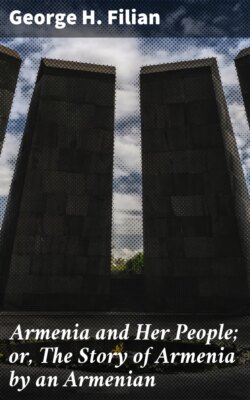Читать книгу Armenia and Her People; or, The Story of Armenia by an Armenian - George H. Filian - Страница 22
На сайте Литреса книга снята с продажи.
ОглавлениеTHE INTERREGNUM.
Table of Contents
Prominent Men; Literature; The Church and the Clergy.
From the time of the partition to the succession of the Pakradoonian dynasty there was not in name an Armenian kingdom; but it must not be supposed that there was not an Armenian nation. No matter how its neighbor nations changed, that country was always called Armenia, and the people held to their Armenian ways and feelings. The national feeling was as strong as before, and above all the feeling of church unity was very intense. No one will ever understand Armenian history, or indeed any Oriental history at all, who does not realize that religious questions come first, and political questions second. The Armenian church was, it is true, a Christian church; but it was the Armenian Christian church, not the Greek church, and the Syrian and African churches had their separate creeds and preferences, and the Greek church, which was the official church of the Greek Empire, was always trying to root out their “heresies” and make them Greek. That was one reason why the Mohammedans conquered those countries so easily. The Africans would rather be ruled by the Mohammedans than by the Greek church, the Syrians were angry because the Greek church wanted to take away their own church and give them the Greek. But the Armenians would not take either the Greek or the Mohammedan or the Zoroastrian; they wanted their own. So they were persecuted terribly by the Greek Christians and the Persian fire-worshipers alike. Just as before the partition, each country invaded the other’s part of Armenia whenever they got into war; and whichever won, the Armenians were the losers. When the Greeks won, they tortured the Armenians; when the Persians won, they tortured the Armenians; later, when the Mohammedans won, they also tortured the Armenians. The mediaeval history of Armenia is that of a battle-ground between contending races—Greeks, Persians, Scythians, Arabs, Seljuk Turks, Ottoman Turks, Mongols, and so on. Millions of its people were slain; millions died of famine and disease; millions of its women were forced to embrace Mohammedanism and become the wives and mothers of Mohammedans—half the blood of those who are called Turks at this day is Armenian; millions of its boys were forced into the Turkish service, so that many of the best-known names in Turkish history, and in the Turkey of to-day, are Armenian names. Yet through all these calamities and decimations Armenia has kept its national life and national religion.
From 390 to 640 the history of both sections of Armenia is little more than an account of religious persecutions and their results; the persecutors on the one side were Christians, and on the other side Zoroastrians, but the results to the Armenians were much the same. The Persian atrocities, however, were on the larger scale, and the outcome was a chronic state of revolt, which will be alluded to in the sketch of Vartan the defender. But the rise of the Saracen power changed Armenia’s greatest foe from the Persian to the Arab, from the fire-worshipers to the Mohammedans. Persia was invaded by the forces of the caliph Omar in 634, and about 640–2 the decisive battle of Nehavend annihilated the last great Persian army, though scattered places held out much longer. The Armenian highlands at once resumed their independence, and their chiefs, with those of the western section belonging to the Byzantine Empire, fought for their own hand in lack of a true national chief whom all could look up to, but allied themselves mainly with the Greek power against the barbarians; and for two entire centuries, and more, Armenia was a furious and bloody battle-ground between Greeks and Saracens, while internally in a state of feudal anarchy. Then a prince of the family of Pakrad or Bagrat (well-known to students of the last century’s history in the form of Bagration), of Jewish descent, as has already been mentioned, which had obtained power over the central and northern parts of Armenia, was recognized by the caliph as an independent monarch; and thus founded the Pakradoonian dynasty, which lasted till Armenia’s independence was once more extinguished by the Byzantine Empire—a crime almost immediately punished by the overwhelming of Asia Minor by the Seljuk Turks.
